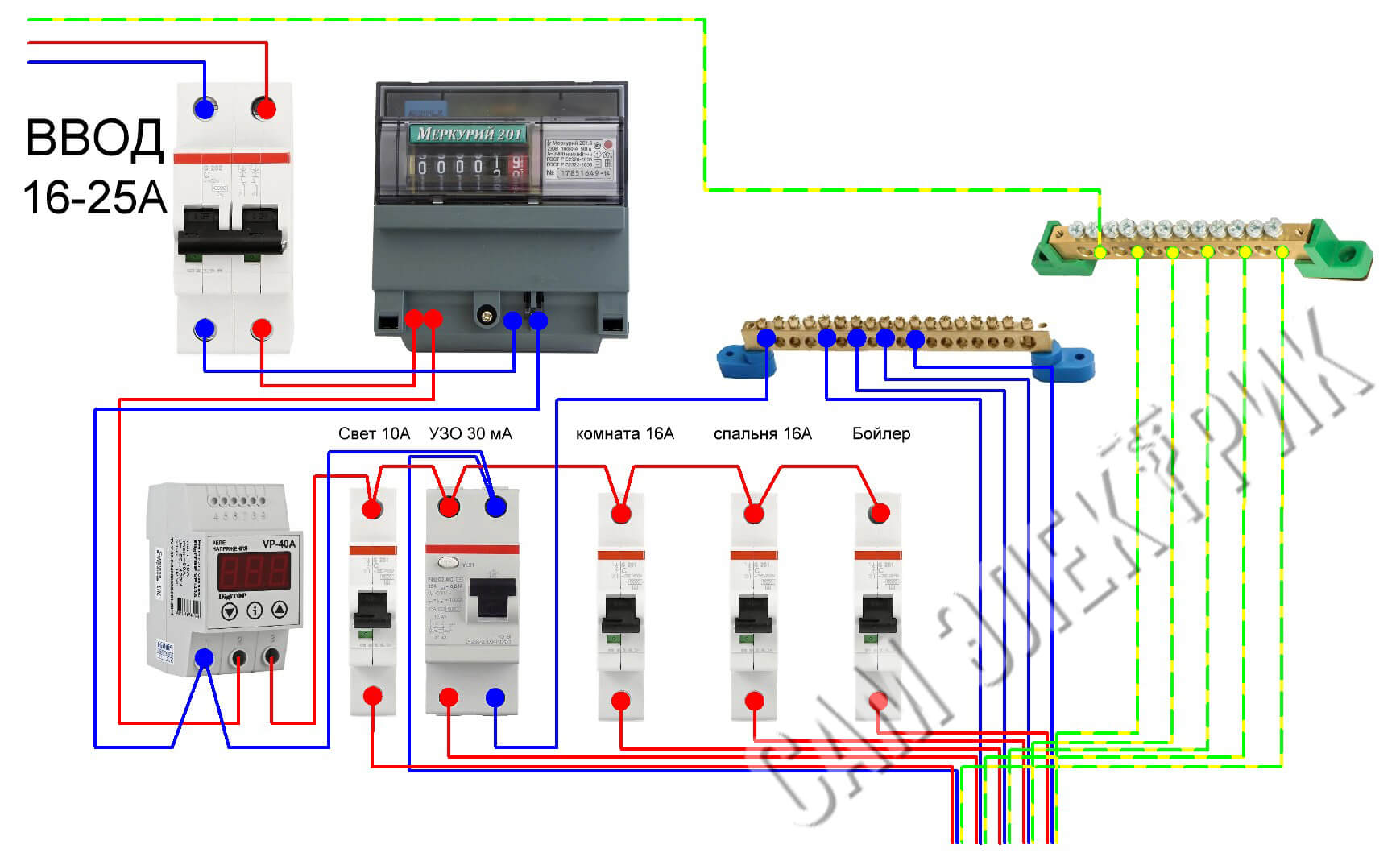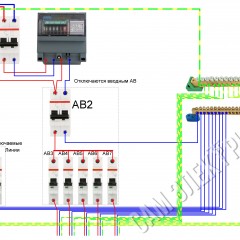How to conduct wiring in the country - step by step guide
- Determining cable routing
- Schematic drawing before installation
- Selection of wiring accessories
- Connection to the VLEP support by air and underground
- Wiring the internal wiring
- Wall marking
- Strobing and recesses for sockets
- Mounting junction boxes and socket boxes
- Laying lines
- Connection of sockets and switches
- Outdoor wiring
Determining cable routing
First you need to determine how you will lay the wiring:
- Internal or hidden wiring. It is laid inside walls, partitions and ceilings. Wiring on the surface of a draft ceiling covered by a suspended or stretch ceiling is also considered internal.
- Outdoor or open wiring. It is laid on the surface of walls, ceilings, structures. In general, in all cases where cable lines are visible.
Selecting the type of wiring is quite simple:
- If you have walls made of brick, concrete, aerated concrete and other solid non-combustible materials - lay the internal wiring.
- A wooden house needs outdoor wiring. AT PUE 7.1.38, it is said that along combustible walls, partitions, ceilings (and behind them), laying is carried out in fireproof pipes and cables that do not spread combustion. Similar recommendations contain other paragraphs of the Rules.
- In a frame house, according to SP 31-105-2002, clauses 13.5.1, 13.5.2, it is allowed to make electrical wiring through voids or the space of walls and ceilings filled with insulation, and it is allowed to pass the cable through the walls without non-combustible sleeves, but the insulation must be non-combustible ( prefixes -ng or -ng-ls in product labeling) or in protective covers.
Schematic drawing before installation
First you need to calculate the number of lamps and switches, to them and sockets. Next, determine where powerful electrical appliances will be installed, such as a boiler, boiler, electric stove. This will allow you to calculate the cable length and draw up a diagram of the electrical panel in the country.
It is worth noting that all electrical installations (facilities) built and reconstructed after 2003 must have grounding (indicated in a number of paragraphs, for example, 1.1.1., 1.7.102-103., 7.1.13., chapter 1.7., GOST R 50571.3-94, etc.). This means that if you are building a summer house now, you need to draw up a grounding wiring diagram. If you have an old cottage and you just make repairs - it is permissible to leave the circuit without grounding, which we do not recommend.
In order for the wiring to be correct and to serve for a long time, it is necessary not only to lay it correctly, but also to choose the correct cross-sections of the conductors and the ratings of the machines.The question arises: how to choose the cable cross-section for a summer residence and assemble an electrical panel with your own hands?
It is necessary to select a cable for the load power. One of the common rules: use wires and cables with a cross section of 2.5 square meters. mm for sockets, and for lighting - 1.5 square meters. mm For an accurate calculation, use the calculator on our website https://our.electricianexp.com/en/raschet-secheniya-kabelya-2.html. An automatic machine for 10A is enough for lighting, and 16A for sockets. If we talk about UZO, then its face value is put higher than that of the machine. Let's say the machine is at 16A, then the RCD is set at 25A. According to the leakage current, the RCDs are selected depending on the purpose: it is better to put 10 mA for the bathroom, 30 mA to protect the entire "wet group".
Now check out a selection of typical schemes of electrical panels for summer cottages:
Scheme of a simple shield without grounding with a single-phase input 220V:
Phase 1 input circuit with grounding:
The scheme with three-phase input 380 / 220V and grounding:
Selection of wiring accessories
In simple words, wiring accessories are sockets, switches, switch boxes, switchboards, etc. On them, as well as on other materials for electrical wiring, you can not save even when repairing in an apartment, even in a country house.
Two brands Legrand and Schneider Electric occupy leading positions in quality and prevalence. In the model range of these manufacturers there are sockets, switches for internal and external wiring, for installation inside and outside - in the suburban area.
Connection to the VLEP support by air and underground
To make wiring, the cottage must be connected to the mains. In almost all cases, an overhead power line passes on the street. Connection to it is possible either by air or underground. Now let's talk about how to make the correct entry into the house and connect to the air duct, as well as which wire to use.
For laying the cable from the support to the house through the air, use SIP wire. For laying underground use either a conventional cable type VVG and it is laid in an HDPE pipe, or in the ground without a pipe an armored cable of the type VBBSHV.
When laying over the air is done branch from the overhead line using cable clamps (ZOI, ZORZB, ZPA, Z 206 and many others), fixed with tension fittings. Next, pull the cable over pipe rack without intermediate supports if the line is less than 25 meters long and with them if the length exceeds 25 meters (more in Chapter 2.4 of the EMP, see clause 2.4.12.).
From the pipe rack mounted on the facade or roof of the house, self-supporting insulated wires lead along the facade in a corrugation made of PVC, if this is not the sunny side. And if the side is sunny, then the PVC corrugation is not suitable - it is destroyed under the influence of ultraviolet radiation, use black corrugation made of polyethylene or metal.
In addition to the pipe stand, the self-supporting insulated wire can be tensioned using tension fittings (also known as anchor clamps) mounted on the facade.
The transition from self-supporting insulated wire to VVG-ng-ls or another copper cable is performed on the facade of the cottage in a moisture-proof junction box, using the same “nut” branch clamps.
Always from the SIP cable and further into the house copper is laid. In addition to laying wires from the pillar to the facade of the cottage, it also occurs when the metering board is installed on a support or in the yard on a pipe stand, in general, the requirements for branching are similar. Near the pipe rack or in another place you need to place an earthing switch, preferably as close as possible to the input shield.
Wiring the internal wiring
So that you don’t puzzle “where to start”, we grouped all the steps in 5 steps for installing the electrical wiring in the country with your own hands:
- Markup.
- Strobing.
- Installation of socket boxes and distribution boxes.
- Cabling.
- Assembly circuit and connection.
Wall marking
It is necessary to determine the location of all electric points. After that, you can mark up future wiring lines. This can be done with anything - with a chalk, pencil or masking cord from the shield to each point. The process of marking walls for wiring is described in more detail in the article: https://our.electricianexp.com/en/kak-razmetit-steny-i-potolok-pod-provodku.html.
The video demonstrates the markup process:
On these lines, you can calculate how much cable is needed for wiring.
It is not worth laying the cable in the floor of the tree - this can be done if it is filled with cement screed in your place. In this case, be sure to use the corrugation to avoid damage to the electrical lines.
Strobing and recesses for sockets
Three main ways make a strob in the wall do it yourself:
- Using a hammer drill with a "chisel" or "awl" nozzle.
- Stroborezom.
- A grinder with a diamond disk.
In principle, they are suitable for all types of solid non-combustible materials. With the help of a chamfer, you will get a smooth and neat chaser, but it doesn’t matter - later it sealed with a solution and putty. Therefore, to make a shtroba with your own hands, you should not buy a shtorez, you can do with a punch.
We make the wells for installing podrozetniki and distribution boxes using crowns with carbide taps or diamond. The standard sizes of the sockets on the outside: depth - 45mm, diameter - 68mm. And the internal dimensions are 68x40mm. However, there are other the size of the sockets, make no mistake when choosing a crown.
To install several sockets and switches in one row - drill several holes, and the segments between them are knocked out with a puncher with a nozzle with a chisel.
Mounting junction boxes and socket boxes
So that the sockets do not fall out of the walls with the plug, it is important not only to install them correctly, but also to secure the socket boxes. For this, screws with dowels are used.
The second way is install rosette and distribution boxes on alabaster. When working with alabaster you need to act quickly. You put so much solution in the recesses so that the sapkin does not squeeze it out too much.
Laying lines
When laying electrical wiring at the cottage in the walls,corrugation use is optional. Use a VVG cable (or VVGng), since there will be no problems with the connection of cores.
The wires themselves are mounted in the wall either with the help of alabaster, or dowel clamps. At this stage, it is important to lay the correct number of wires for all power consumers.
Connection of sockets and switches
The last stage is performed after plastering and drying the walls. The plaster is wiped and sockets are installed. There are no special recommendations, you just need to install all the elements exactly, in level. On this step-by-step description of hidden wiring can be considered complete.
If you do not know how to install sockets and switches, check out the articles:
- https://our.electricianexp.com/en/kak-pravilno-ustanovit-rozetku-svoimi-rukami.html
- https://our.electricianexp.com/en/kak-pravilno-podklyuchit-vyklyuchatel-sveta.html
Outdoor wiring
We examined how to lay the internal electrical wiring in the country in stages, now we will consider another type - external wiring. Laying external wiring in a country house is simpler and takes less time. According to the PUE, the external wiring must be performed with cables with insulation that does not support combustion. Which cable to use in this case? The same VVGNG-LS, or other cables with such insulation, is suitable.
Modern requirements require the use of localizing non-combustible pipes - that is, metal. Copper or steel thin-walled pipes can be used. But this option is not the cheapest and most convenient for installation.
Also, the wire can be laid in PVC corrugation. If this option does not suit you - lay in the cable channel or baseboard with a niche for wires.
The installation of sockets and switches for outdoor installation is different in that you do not need to drill holes and install socket boxes - they just screw onto the wall. This can be called an “economical option” because it is easy to replace such wiring, add or remove sockets and transfer switches without any special costs and visibility of alterations.
An alternative to this solution is retro style electrical wiring. To do this, use a special twisted wire and ceramic rollers, this method is fully consistent with the requirements of the PUE. Its main disadvantage is the high cost of both the cable itself and the old-fashioned wiring accessories.
That's actually all the points that you need to know if you decide to independently conduct electrical wiring in the country. We hope that our step-by-step instructions with pictures and diagrams helped you understand where to start and what you need to do in general!
Related materials:




















